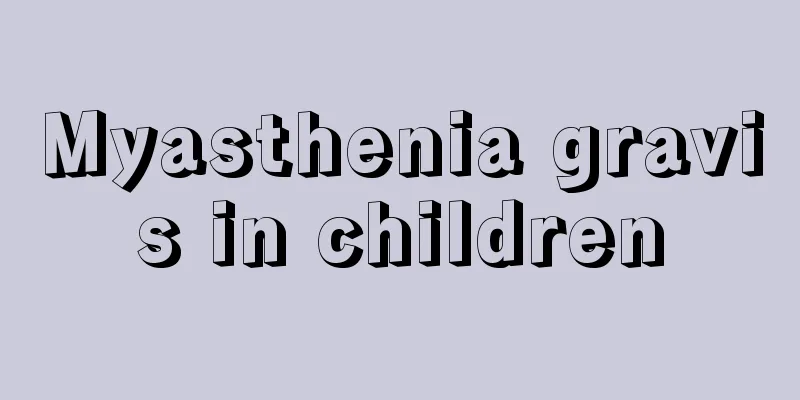Myasthenia gravis in children

|
Myasthenia gravis is a common mental illness. Myasthenia gravis in children is also a common infant disease. It may be caused by genetic genes or viruses. It is an autoimmune disease. There are many causes of its onset, which we don’t know much about. We only know that there is such a disease, but we don’t know the specific causes, symptoms, and treatments. In order for our children to grow up healthily, as parents we need to understand various diseases that infants and young children are prone to, understand their symptoms, causes and treatments, so that we can better prevent and provide first aid. Today, let's learn about myasthenia gravis! Diagnosis of myasthenia gravis should be differentiated from other diseases 1. Identification of myasthenic crisis Two types of crises may occur in patients with myasthenia gravis, namely myasthenic crisis and cholesteric crisis. The clinical manifestations of the two crises are very similar, both showing severe muscle weakness and respiratory failure. The former often has a history of infection, trauma, mental shock or irregular medication; the latter may be accompanied by manifestations of cholesteric hyperfunction, such as pallor, sweating, diarrhea, muscle tremors, pupil constriction, cold and wet skin, etc. When differentiation is difficult, a tensilon test can be performed. If the symptoms improve after medication, it is a myasthenic crisis, otherwise it is considered to be a cholesteric crisis. 2. MG acute myasthenia should be differentiated from other acute paralysis diseases (1) Periodic paralysis often occurs at night. When patients wake up, they find their limbs weak. When the disease occurs, the blood potassium level is low and U waves appear on the electrocardiogram. Each attack lasts for several days and is effectively treated with potassium supplementation. (2) Acute inflammatory demyelinating polyradiculopathy initially presents with fever or diarrhea. In addition to limb paralysis, there is also nerve root traction pain and protein-cell separation in the cerebrospinal fluid. (3) Myelitis presents with fever and the three major symptoms and signs of spinal cord damage (including upper motor neuron paralysis, transverse sensory impairment and urinary dysfunction). 3. Chronic myasthenia needs to be differentiated from the following diseases (1) Oculomotor nerve palsy: In addition to ptosis, the pupil may also be dilated and the upward, downward and adduction movements of the eyeball may be limited, which is seen in neuritis or intracranial aneurysm. (2) Polymyositis causes proximal muscle weakness, myalgia, elevated muscle enzymes in the limbs, and inflammatory cell infiltration in muscle biopsy. (3) Muscular dystrophy: slowly progressive limb weakness, muscle atrophy, winged scapulae in children, pseudohypertrophy of the gastrocnemius, elevated blood myocardial enzymes, and a family history. (4) Mitochondrial myopathy: Skeletal muscle is extremely intolerant to fatigue and the symptoms are complex and varied. Blood lactate is elevated and irregular red-edged fibers can be seen in muscle biopsy. Electron microscopy shows abnormal mitochondria. (5) Glycogen storage disease, especially type II patients, has acid maltase deficiency that causes limb girdle muscle weakness and respiratory muscle paralysis. It is easy to misdiagnose. PAS staining of muscle biopsy can show glycogen accumulation, and there is a family history. (6) Cancerous myasthenia is mainly seen in elderly patients with small cell lung cancer. The patient is characterized by limb weakness that is relieved by activity. Repeated high-frequency electrical stimulation of the nerve electromyogram shows an increase in myoelectric potential. (7) In the early stages of motor neuron disease, only weakness of the tongue and limbs is present. The physical signs are not obvious and it is difficult to identify. However, if muscle atrophy, muscle fiber fibrillation or pyramidal tract signs occur, it is not difficult to identify. complication When myasthenia gravis patients cannot maintain basic living and vital signs due to difficulty breathing and swallowing, it is called myasthenic crisis, and the incidence rate accounts for approximately 9.8% to 26.7% of the total number of myasthenia gravis. Myasthenia gravis may be accompanied by other diseases, such as thymoma, followed by hyperthyroidism, and a few may be accompanied by rheumatoid arthritis, lupus erythematosus and autologous hemolytic anemia. treat 1. Commonly used anticholesterase drugs Including neostigmine bromide, pyridostigmine, etc. Its main function is to inhibit the activity of cholesterase and reduce the degradation of acetylcholine, thereby increasing the concentration of acetylcholine in the synaptic cleft and playing a therapeutic role. The dosage depends on the patient's age and response to the drug. A small dose should be used at the beginning of treatment, and it should be maintained after achieving satisfactory therapeutic effect. It is best to give the next dose before the drug effect disappears to avoid myasthenic crisis. During medication, pay attention to the cholestatic side effects to avoid cholestatic crisis due to overdose. As an effective symptomatic and auxiliary treatment drug, cholesterase inhibitors should not be used alone for a long time. The use of medication varies from person to person and from time to time. Start with a small dose and gradually increase the dose to maintain the patient's eating and daily activities. Long-term dependence and abuse of cholesterase inhibitors will hinder AchR repair, and the disadvantages of such drugs must be avoided. Auxiliary drugs such as potassium chloride and ephedrine can enhance the effect of neostigmine. Avoid using drugs that block neuromuscular transmission, such as various aminoglycoside antibiotics, quinidine, procainamide, propranolol, chlorpromazine and various muscle relaxants. 2. Immunosuppressive drugs Adrenal cortex hormone can inhibit the body's autoimmune response, restore the normal function of AchR and play a therapeutic role. In the past, it was believed that adrenal cortical hormones were suitable for: severe generalized myasthenia gravis; poor response to anticholesterase drugs even though it was an ocular muscle type; poor efficacy or worsening symptoms after thymectomy, etc. In recent years, most authors have advocated the use of hormonal therapy for nearly all patients with myasthenia gravis. (1) Corticosteroids are the most commonly used immunotherapy drugs and can be used for both ocular and systemic immunotherapy. (2) Other immunosuppressive drugs include cyclophosphamide, azathioprine or cyclosporine, which are effective for refractory cases, crisis cases, and patients with poor response to thymectomy. Attention should be paid to changes in blood count, liver and kidney function. 3. Thymectomy Thymectomy remains the mainstay of treatment for MG. It is suitable for patients whose symptoms relapse after stopping hormone treatment for more than one year, or for patients with no obvious effect of hormone treatment. Surgery is more effective and may even result in complete recovery in the first few years of the disease. Prednisone was continued for 1 year after surgery. Applies to: (1) Systemic MG is not well treated with medication and surgery should be performed as early as possible. The surgical effect is very good in middle-aged female patients within 3 to 5 years of onset. (2) Although the therapeutic effect is poor for patients with various types of MG accompanied by thymoma, surgical resection of the lesion should be performed whenever possible. (3) Although surgery is effective for children with ocular myopathy, whether it is worthwhile remains controversial. Proper perioperative management and prevention of crises are the key to reducing mortality. 4. Plasma exchange and other therapies Plasma exchange can quickly remove AChRab and immune complexes in plasma, which helps to relieve the condition. It is used to rescue crises and can quickly relieve symptoms, but the effect is short-lived and must be followed by follow-up treatment. Its treatment includes adding potassium chloride or ephedrine, which is expensive. 5. Human immunoglobulin Use large doses of human immunoglobulin intravenously for 5 consecutive days. It is safe and effective for treating patients with severe systemic MG, quickly reversing the crisis, or for preparation before surgery. Other treatments should be added promptly after use. 6. Avoid using drugs that aggravate muscle weakness Including neomycin, streptomycin, kanamycin, polymyxin B, lincomycin, quinidine, propranolol, phenytoin sodium, etc. 7. Treatment of myasthenic crisis and cholestatic crisis The crisis incidence rate in pediatric cases was 2.2%, and the mortality rate was 0.8%. Once a crisis occurs and the respiratory muscles are paralyzed, special attention should be paid to ensuring that the airway is open. Tracheal intubation or tracheotomy should be performed immediately, and artificial respirator should be used to assist breathing. At the same time, the type of crisis should be identified and symptomatic treatment should be given. During the crisis treatment process, maintaining aseptic operation of airway care, nebulization inhalation, keeping the airway open, and preventing complications such as lung infection and atelectasis are the keys to successful rescue. When myasthenic crisis occurs, adequate doses of anticholesterase drugs should be used. In the event of cholestatic crisis, anticholinesterase drugs should be discontinued, and atropine can be given to counteract their muscarinic effects. 8. Radiation therapy Thymus radiotherapy is still an effective treatment for MG. It is called "non-surgical surgical treatment". Applies to: (1) For patients with MG who do not respond to medication, early radiotherapy is best performed within 2 to 3 years of onset. (2) Giant or multiple thymomas that cannot be treated surgically or as preoperative preparation. (3) Additional radiotherapy after surgery for malignant tumors. The above are the treatment methods and identification symptoms of myasthenia gravis. Parents can have a preliminary understanding to prevent their children from suffering from myasthenia gravis. There are many other diseases for infants and young children. Parents can learn about other diseases themselves. |
<<: Daily prevention of wind-heat cold in children
>>: 7 situations when you must go to the hospital urgently when you have diarrhea
Recommend
Why does my child yawn all the time?
If a child yawns frequently, he will soon realize...
The treatment of sinusitis in children is like this
Sinusitis in children has a great impact on their...
Baby has diarrhea and mucus in his poop
Since the baby is too young and cannot speak, if ...
Treatment for newborn spitting up milk from the nose
It looks very scary when a newborn baby spit up m...
Treatment of fever in children
It is the common wish of every parent that every ...
Why does the child have blood in his stool?
Parents are more concerned about their children&#...
What to do if your child grinds his teeth while sleeping at night
In fact, families with children will have discove...
What are the preventive measures for infectious diseases in spring for young children?
With the arrival of spring, various infectious di...
What to do if your baby won't use a bottle
The situation that babies don't know how to u...
Can children's growing pains be relieved by soaking their feet more often?
Growing pains can be said to be a problem that ch...
Why does my child vomit in the middle of the night?
As a new mother, I am often overwhelmed by some d...
Is it okay for a one-year-old baby to toss and turn when sleeping at night?
Babies are very quiet when they sleep, because th...
Children cough when they run hot
If our baby coughs when exercising, it may be cau...
What to do if your newborn spits up while lying down
Spitting up is a common symptom in newborns. This...
What causes vascular malformations in babies?
For many children, some diseases are more common ...









